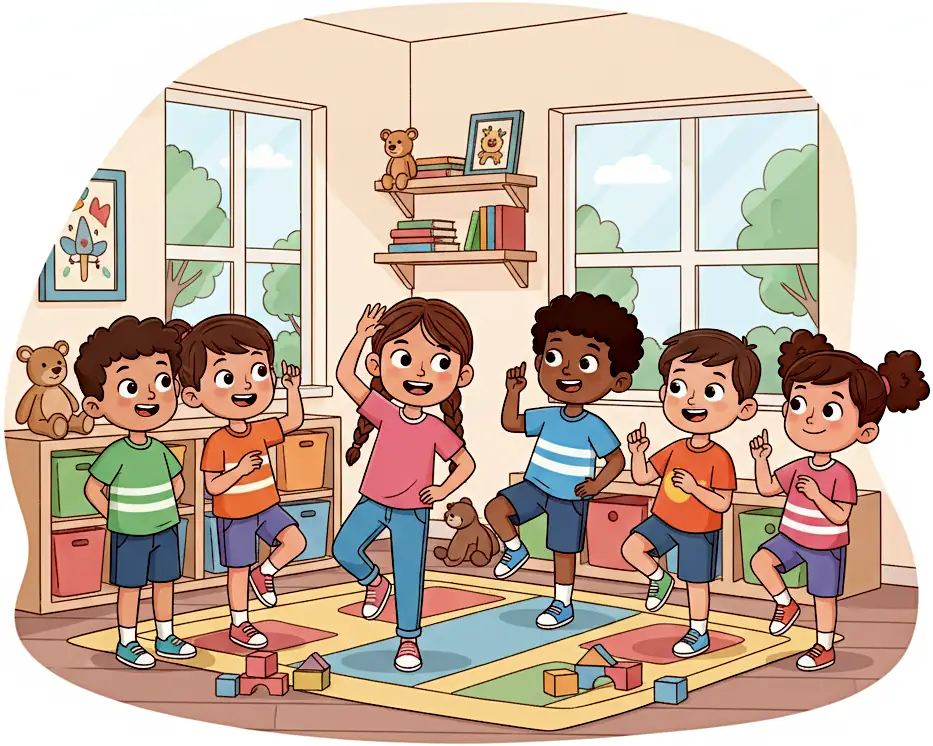The Simon Says game is a classic, easy-to-learn party game that tests listening, reflexes, and memory. Whether you’re leading a group of kids at a birthday party, running a classroom activity, or looking for light team-building exercises, the Simon Says game offers flexible fun and simple setup.
In this post you’ll learn how to play, discover the original Simon Says game rules, explore memory-based variations, and find several games like Simon Says to rotate through.
Table of Contents
What is the Simon Says Game?
The Simon says game is a verbal instruction game in which one player (the leader or “Simon”) issues commands and participants must follow only those commands prefaced by “Simon says.” The goal is to catch players who act on commands that omit the key phrase. This simple mechanic makes the game fast, inclusive, and ideal for mixed ages.
How to Play the Simon Says Game (basic rules)
To learn how to play Simon Says, follow these steps:
- Select one player to be “Simon.”
- Simon gives commands such as “Simon says touch your nose” or simply “Jump.”
- Players must only follow commands that begin with “Simon says.” If Simon issues a command without saying “Simon says,” anyone who follows it is out (or receives a light penalty for non-elimination play).
- Last player remaining wins, or rotate Simon to keep the game moving.
These rules capture how to play Simon Says in its most common, original form. For younger children, skip eliminations and use gentle reminders to keep the mood positive.

Simon Says Game Variations and Games Like Simon Says
There are many fun spins on the original Simon Says game that refresh the play experience and increase difficulty:
- Memory Game Simon Says: Chain commands so each player must repeat the previous sequence and then add one new action, blending Simon Says with a memory challenge.
- Speed Simon: Commands come faster and faster to test reflexes.
- Silent Simon: Use gestures only—players must act only when the leader makes the agreed signal plus the phrase, combining visual cues with listening skills.
- Physical Challenge Version (games like Simon Says + obstacle): Add movement through cones or around chairs to turn the game into an active relay.
- Simon Handheld Electronic Memory Game With Lights and Sounds (sponsored link)
These variations show how a game similar to Simon can emphasize memory, speed, or physical skill depending on your goals.
Tips to Win the Simon Says Game
Winning at the Simon Says game is as much about attention as agility. Try these practical tips:
- Focus on the leader’s exact words; pause before you act to confirm “Simon says” was included.
- Watch other players—false starts can be instructive.
- If you lead, mix predictable and surprising commands to keep the group engaged.
Using the Original Simon Says Game for Education and Parties
The original Simon Says game is a versatile tool for teachers and party hosts. It reinforces listening comprehension, follows simple instruction standards, and encourages social interaction. For classrooms, tie commands to learning goals (e.g., “Simon says point to the vowel in the word on the board”) to make play educational.
Quick List: Games Like Simon Says to Try Next
If you love the challenge and laughter that come with the Simon Says game, you’ll enjoy trying other games like Simon Says that use similar listening, memory, and reaction skills. These alternatives are perfect for classrooms, parties, or family gatherings and can easily be adjusted for different age groups or group sizes. Each one keeps players alert, active, and entertained while reinforcing focus and coordination.
- Red Light, Green Light (similar stop/go mechanics)
- Follow the Leader (movement-based imitation)
- Memory Sequence Games (combine with cards or objects)
- Statues/Freeze Dance (reactive listening and movement)
FAQ
Before wrapping up, here are some of the most common questions people ask about the Simon Says game. Whether you’re new to the game or looking for creative ways to play Simon Says with different groups, these quick answers will help you make the most of this timeless activity.
How do you play Simon Says with a large group?
Use clear, loud commands and assign helpers as spotters to watch for mistakes. For very large groups, split players into teams and score teams instead of eliminating individuals.
What age is the Simon Says game best for?
The Simon Says game works well for toddlers through adults. Simplify commands for younger players and add memory or speed components for older children and adults.
Is Simon Says a memory game?
Traditional Simon Says is mainly a listening and reaction game, but you can create a memory game Simon says variant by requiring repetition of previous commands before adding new ones.
Where did the original Simon Says game come from?
The original Simon says game has roots in playground and parlor games that date back many years; while its exact origin is unclear, the pattern of “do X only if instructed by Y” is a long-standing folk game format.
Final Thoughts
The Simon Says game remains one of the simplest yet most entertaining activities for all ages. It encourages laughter, focus, and friendly competition — making it ideal for parties, classrooms, and family nights.
If you’re looking for more inspiration and fun ways to keep your guests entertained, explore our full collection of party games to discover new favorites and creative twists on classic games.

